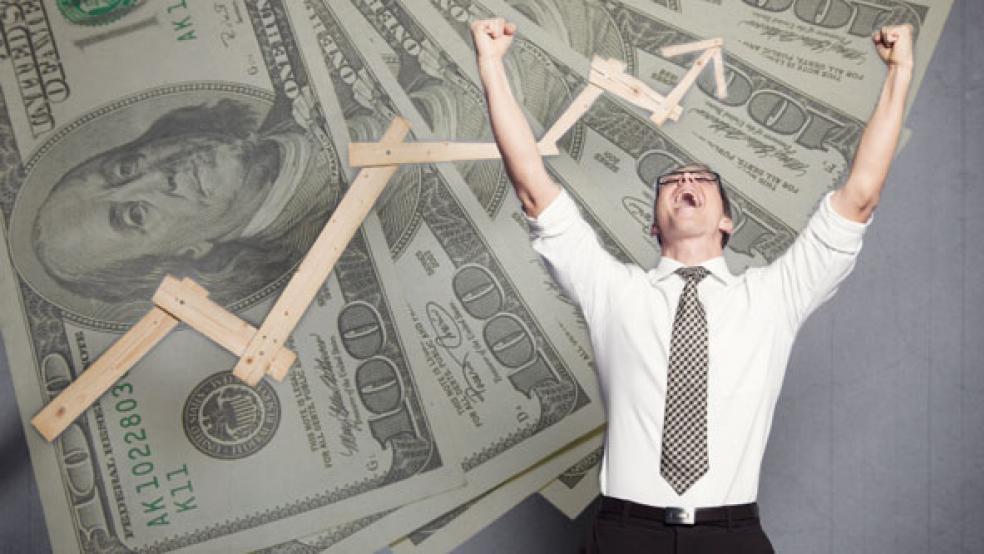Warren Buffett is buying. Investors are socking money into equity mutual funds. Even the Federal Reserve wants you to buy stocks – or at least, their policy of keeping interest rates at absurdly low levels is clearly designed to prod us all into being willing to take more risk in our portfolios, or pay the price in flat returns and outsize interest rate and credit risk. This year, we have finally listened and acted: flows into stock mutual funds hit 12 year highs in the early weeks of 2013, and yesterday, the Dow Jones industrial average finally completed its long and often painful climb out of the abyss to set a new all-time high, breaking above the previous record set in October 2007.

That means that finally, almost exactly five years to the day since the collapse of Bear Stearns heralded the worst of the financial crisis, and almost exactly five years to the date that the Dow bottomed out at only 6,547.05, the blue-chip index finally has managed to erase the losses it recorded during the crisis and its aftermath. That’s only 1,004 trading days, and thus not as long as the 1,267 trading days required for the Dow to recover from its 2001 swoon and the ensuing bear market, according to data from S&P Dow Jones Indices. But it’s still an impressive feat, especially given the context: underwhelming economic growth at home, a long-running European fiscal crisis, the uncertain outlook in China and, above all, the ugly Washington battle over the country’s finances.
Indeed, the stock market set this new record days after Washington’s legislators failed to avert sequestration: $85 billion of forced government spending cuts to discretionary spending, including military budgets. Yet even defense contractors joined yesterday’s rally, with Raytheon (NYSE: RTN) climbing more than 1 percent, General Dynamics (NYSE: GD) up 0.94 percent and Northrop Grumman (NYSE: NOC) 0.84 percent higher. (By way of comparison, the Dow jumped 0.89 percent, or nearly 126 points, to hit 14,253.77.)
The fact is, the alternatives to stocks are looking pretty underwhelming. If there is a market bubble taking shape out there, it isn’t in stocks, even though the Dow is now up nearly 9 percent so far this year and has advanced 11.7 percent in the last 12 months. The bubble is in bonds, where Fed policies have driven even the yields on junk bonds as low as 5 percent to 6 percent, depending on which index you select. Ask most sensible investors about that, and brace yourself for a lecture on how badly risk and return can get out of sync when monetary policymakers lean in one direction for too long.
What’s behind the bull market? The answer is relatively simple. While the economy isn’t delivering impressive gains, on the margins things seem to be improving. Corporate earnings remain historically strong. Chinese leaders vowed to keep that country’s growth close to 7.5 percent this year; the European economic crisis isn’t in high gear, the U.S. housing market continues to strengthen – and above all, stocks are still cheap, with the 30 Dow components trading at only about 14 times earnings. That’s well below the level the index was trading at back in 2007, and a valuation that many asset allocators view as cheap on a historical basis – especially in light of the unexpectedly robust fourth-quarter earnings season, only now wrapping up.
“The market is inclined to thinking that the glass is half full,” argues Paul Atkinson, head of North American equities for Aberdeen Asset Management. ”Corporate profitability, equity valuations relative to bonds – well, you can see why people are committing assets to equities.”
But all the hoopla over the Dow’s record doesn’t mean that we might not be due for some kind of selloff – the faster and higher the market indices climb, the more likely it is that one will occur. After all, market pundits point out, if you annualize the nearly 9 percent gain so far this year, you’d be in for a rally of 50 percent or so in the Dow for 2013 as a whole. And that is plainly irrational. It’s also unlikely that after gaining 9 percent so far this year, the Dow will simply sit placidly on the sidelines for the next 10 months, waiting for the year to be over. The catalyst for a selloff may still be unknown, but the odds are growing that there will be one.
The nagging question for stock market bulls is whether the selloff would be the same kind that we have seen in each of the last two years, one that put an end to a nascent rally and kept the lid on market’s gains. In both cases, rallies early in the year ended sometime in the second quarter, leaving stocks to retrace their path during the rest of the year. “We have had false moves in the last two years; false dawns, really,” admits Atkinson. “But this time, corporations aren’t getting over-excited about their earnings potential” and thus aren’t encouraging investors to drive up valuations. On the contrary, companies are being extremely wary. But that doesn’t mean that Atkinson and his peers are trimming their own earnings forecasts for 2013, he adds.
Some kind of resolution of the latest budget standoff in Washington could give the current rally some more momentum, but then it will be up to those corporate earnings to carry it further. Disappointments or even underwhelming forward-looking statements could prove to be a bearish catalyst. Headline risk from Europe remains a threat as well.
Then there are the market’s technical characteristics. In a report published yesterday, Mary Ann Bartels, technical research analyst at Bank of America Merrill Lynch, notes that sentiment readings are higher than they were ahead of the market break last September, and just below those seen in March of last year, when stocks broke their early winning streak. “Investors may be too bullish on the U.S. equity market,” the report warns.
The new record for the Dow may be a landmark, but that’s all. The breadth of the rally – all but three of the Dow’s 30 stocks participated – is encouraging, but any rally needs fuel to keep moving. And the further it is able to advance, the larger the potential decline when the market temporarily runs out of good news to fuel it. The laws of physics kick in. So celebrate and enjoy. But remember that durable rallies are achieved only by climbing the proverbial “wall of worry.”






